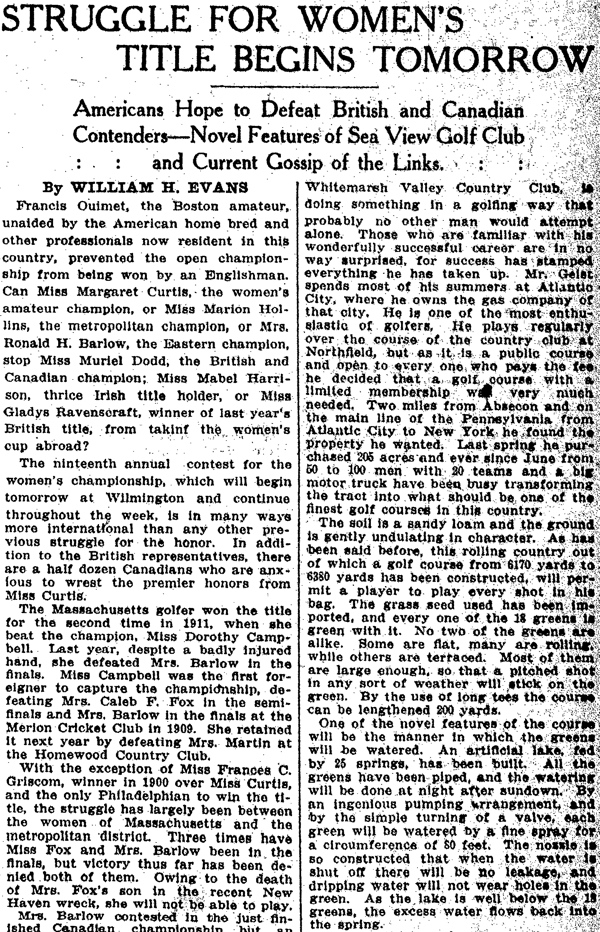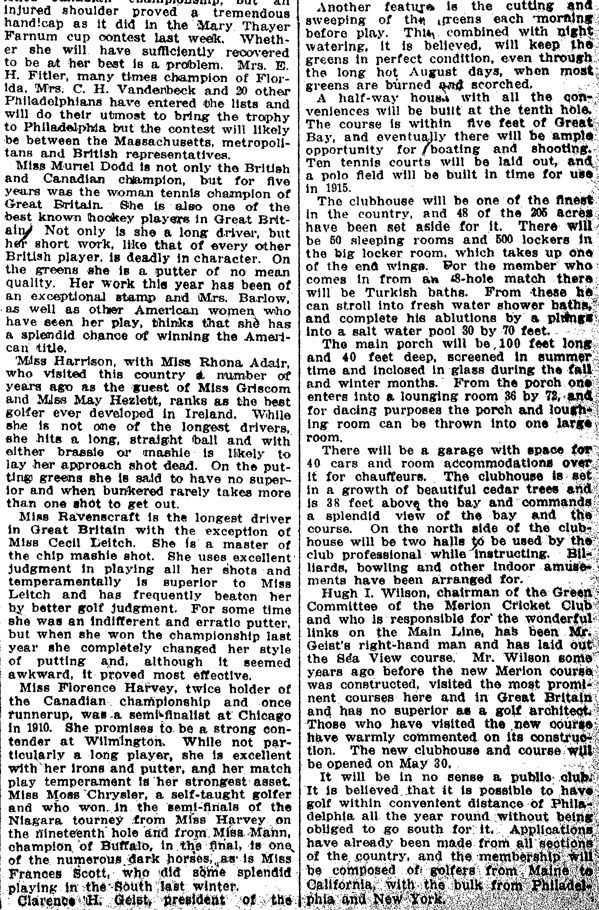An interesting compilation, I'm still trying to figure out if you are trying to make a case for Wilson or trying to uncover what really happened. Why did you find it necessary to dissect arguably the most important article and the one that seems to lean toward Robinson. Why did you do that?
Tom MacWood,
Although I thought the meaning of most of the article were self-evident, rendering additional commentary redundant, I thought the first article needed some dissection because I don't think most observers here would know who Bispham and Nicholls were, and because I believed that your reading of that article was in error, although I can understand that as there are a number of factual errors in the article itself, among them;
1) I don't believe the club was ever known as "Sea
side"
2) Bispham was not the founder of Philadelphia Country Club and his name is misspelled
3) The article almost reads like a advertisement or prospectus. I've never seen any indication that this was anyone's idea but Geist's, but yet it says he "heads a group of golf enthusiasts", and "is being supported by men equally as well known."
4) No other reports concur that "efforts will be made to make it (the course) one of the most difficult in the country." Quite the opposite in fact.
5) The article shifts from talking about Bispham and Nicholls and Geist being "the prime movers in the establishment of the club" to William Robinson being charged with laying out the course and states Robinson "has invited opinions of other experts (note the past tense) in his work...". so I can see where it's easy to mix the two ideas.

But, for discussion purposes,let's take the article as 100% factual and at face value. I think Jeff Brauer's comment about the "Project Manager" is the way it reads to me. Robinson was from the area, Geist certainly knew him well from Atlantic City CC as well as from Spring Lake. Most of the "experts" Geist knew well at the time were in Philly, or New York, and not able to be onsite every day so it certainly made sense to put Robinson in that role of onsite coordinator of activities and Geist's "eyes and ears", so to speak, especially given Geist's plans to reclaim usable land from the swamps.
In any case, I have a question of my own.
Is it more relevant to be cited as the architect of record in an article prior to a course being built or after?Did Tom Fazio design Stonewall or did Tom Doak? Was Gil Hanse the architect of record at Odessa National (DE), or was it Joel Weiman? How about at the Prairie Club...will future historians find early evidence that Hanse and Shackelford did the course and argue that Lehman and Marsh were being given undue credit??

In all of those cases there was someone different involved at the start of a project than who we know today the architect of record, or person we'd give most credit to today based on knowing the facts. Today we know these things because they happened in our lifetimes, and because our documentation processes are probably more current and complete, but what is a historian/golf archeologist 100 years from today going to do when he comes across a Fazio routing for Stonewall and thinks he's made some new discovery that willl upset all of those romanticists of that future time protecting their valued "Doak Myth"?


Probably the best example of this is Pine Valley.
In March 1913, the following article appeared, written by Tillinghast;


Based on this article, are we now to assume that Harry Colt gets no credit for the golf course, or had nothing to do with the routing or hole internals? (p.s....Careful readers will note that Crump's group who was out there routing the course was called the "Construction Committee", exactly as Hugh Wilson's had been called at Merion)
Colt wouldn't even be at PV until some months later, and from the sounds of the article, a heckuva lot of work had already been done and a routing devised. By what you seem to be arguing about Robinson, should we simply make George Crump the sole designer of Pine Valley?


Of course not. In the following article, two months after that initial Seaview article, it's clear that Robinson did indeed get the help he was looking for and indeed, experts with prior experience did in fact lay out the course. Do you think it was Robinson who saw the need to create lots of width to adequately separate the holes, or Robinson who created such wild, undulating, large greens that virtually everyone saw them as somewhat unique and even surpassing what Travis had done at Garden City or Robinson who created tees 60-70 yards long to create lots of flexibility in the course on a windy site with many beginning vacationing golfer, or imported the grass seed from abroad?
Using your terminology, Robinson was a "complete novice", having never done any work of this type before. Why would you suddenly shift your philosophy and suddenly believe that a rich guy with expensive tastes like Clarence Geist would have his "monument to himself" designed by someone with no experience in the art?
Wouldn't he have turned to an "expert", particularly one who was a close personal friend, and who had just designed and built what was acclaimed as the best course in Philadelphia and who had studied both architecture and agronomy in the words of Max Behr, "like no one before him (them)"?

Of course he would. All of the subsequent articles, including this detailed one that followed two months later, tell us who the "experts" were, and Wilson himself tells us he used Fred Pickering for construction at Seaview.


I think I'm being fair in saying that the course that opened at Seaview was a "Wilson/Robinson" course, because I'm definitely a believer in giving credit to the person put in charge of projects, whether they are simply providing high-level oversight, or detailed assistance. But, we don't know for sure who did what, do we? Which is why we have to look at these things comprehensively, and weigh all the evidence at hand, and give our best judgments, and see what others think.
I certainly think I'm being more fair than all of those early writers who quickly cited Wilson and quickly forgot whatever Robinson's contributions were to Seaview.
Finally, I think it's interesting to note how the different papers in those articles treated their subjects. Hugh Wilson in 1913 would have been well-known among golf cognescenti in Philadelphia, but not far beyond view of William Penn's hat. E.K. Bispham was a familiar socialite at the shore, vacationing and playing out of Cape May Golf Club with his wife in many of the mixed tournaments. Geist was from Chicago and would have been known well in both Philly and Atlantic City.
The mention of Hugh Wilson only seems to be in the Philadelphia papers. In the Atlantic City article the reference was to "experts", and in the Chicago Tribune article is simply says "one of the best golf architects", which gave some credence to Geist's project without having the local readership rubbing their temples saying, "Hugh WHO"?